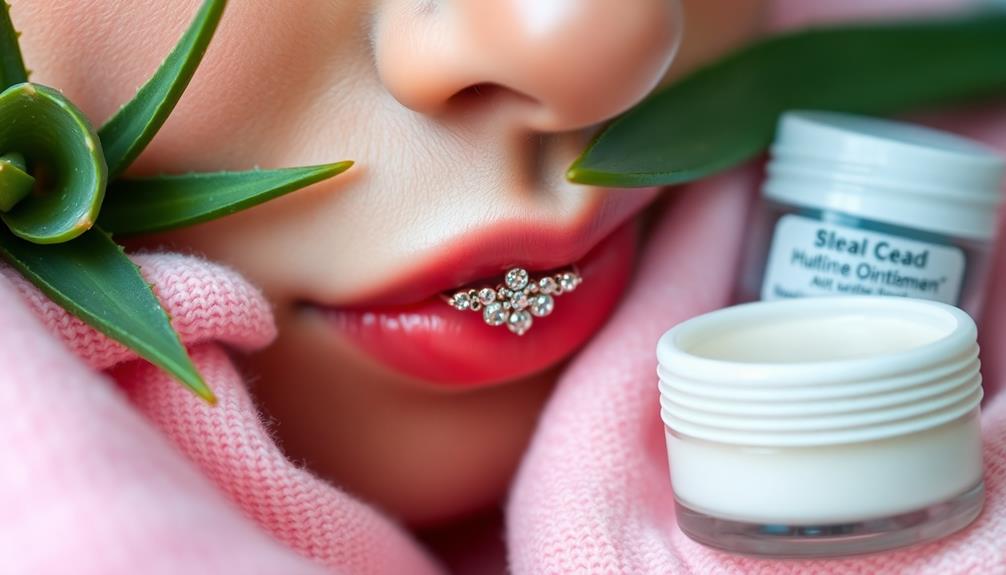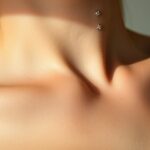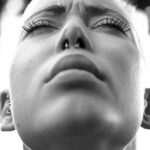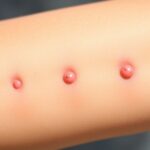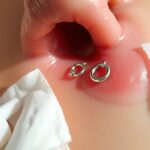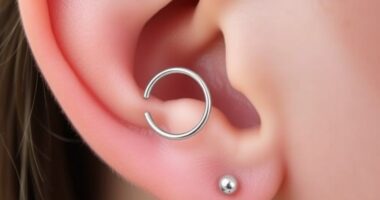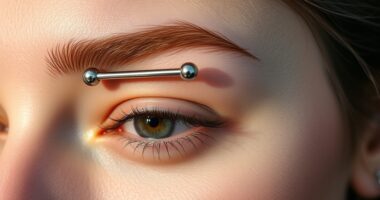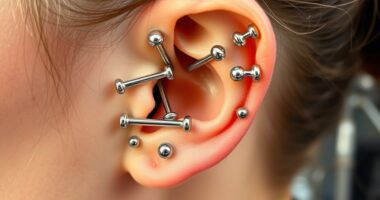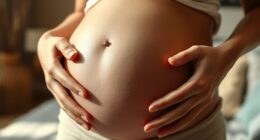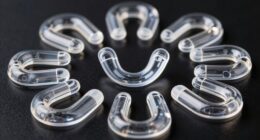Nipple piercings offer a striking look, but they come with some discomfort. You can expect a pain level of around 7/10 during the procedure, with initial sharp pain giving way to a dull ache for weeks. Healing takes about 6 to 12 months, with soreness easing in the first month. Aftercare is essential; clean your piercing twice daily with saline and avoid tight clothing to prevent irritation. Keep an eye out for signs of infection, like excessive redness or discharge. To keep your piercing healthy, learn about the best jewelry choices and aftercare tips that can make a difference.
Key Takeaways
- Nipple piercings generally have a pain level of around 7/10, with initial sharp pain subsiding quickly to a dull ache.
- Healing time for nipple piercings ranges from 6 to 12 months, with noticeable progress in the first few weeks.
- Proper aftercare involves cleaning the piercing twice daily with saline solution and wearing loose-fitting clothing to prevent irritation.
- Signs of proper healing include decreased pain and clear lymph fluid, while persistent redness or discharge may indicate infection.
- Choose titanium jewelry to minimize allergic reactions, and ensure the size accommodates swelling during the healing process.
Understanding Nipple Piercings
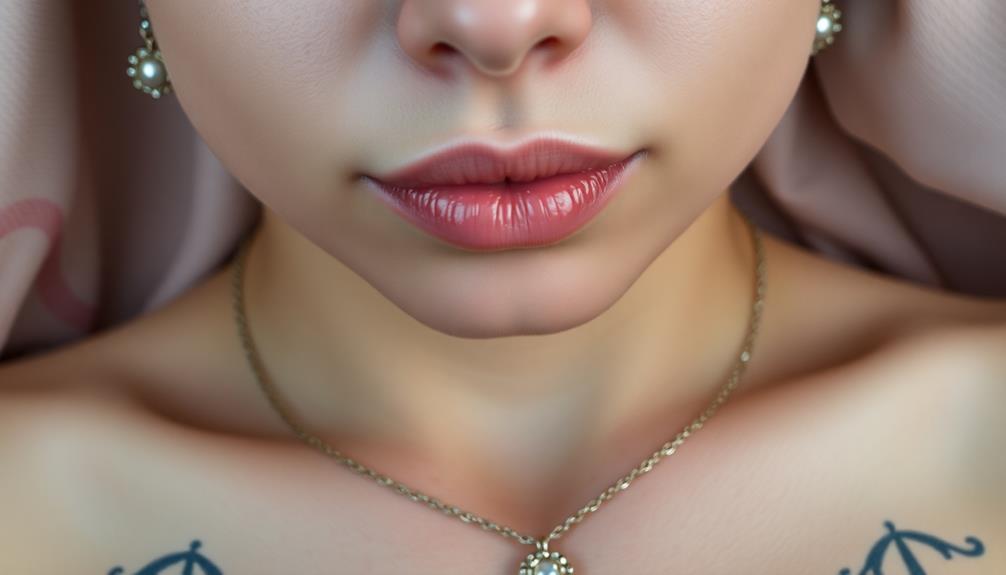
Nipple piercings are a unique form of body modification that involves creating a hole through the skin of the nipple. This procedure can be performed on one or both nipples and is generally more complex than traditional lobe piercings. You'll want to visit a professional piercer to guarantee the procedure is done safely and effectively.
The healing time for nipple piercings typically ranges from 6 to 12 months, and it's vital to follow proper aftercare during this period. This includes cleaning the piercing with a saline solution twice daily and avoiding irritants that could complicate the healing process. Wearing loose clothing can also help facilitate healing.
As you monitor your healing, keep an eye out for signs of infection, such as increased redness, warmth, or pus. Healthy healing is indicated by decreasing pain and swelling, along with clear lymph fluid discharge.
Understanding these aspects will help you navigate your nipple piercing experience, making it a rewarding addition to your body piercings. With proper care and patience, you can enjoy your new nipple piercings while minimizing potential complications.
Pain Level Assessment
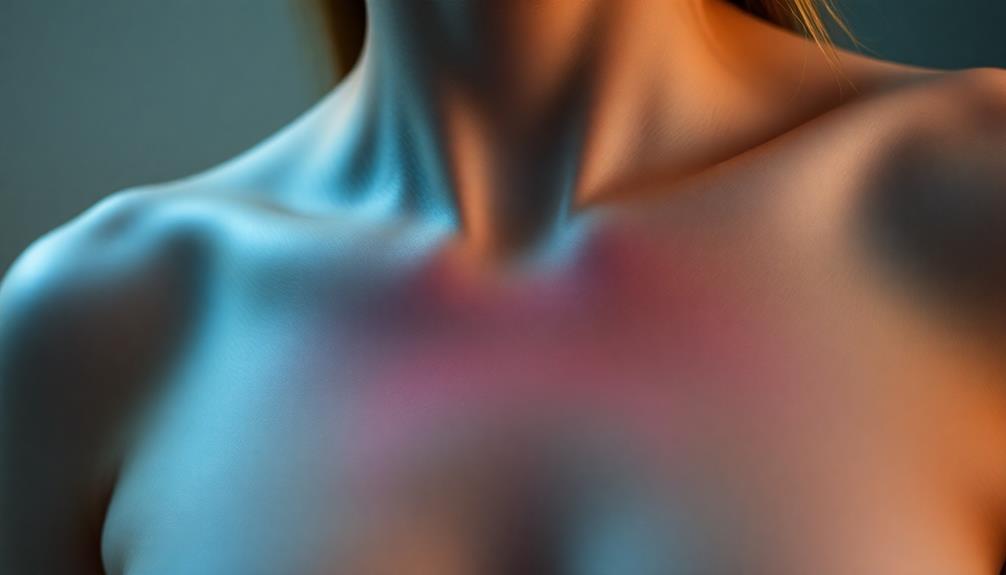
When considering nipple piercings, it's important to recognize that pain perception varies from person to person.
You might experience sharp pain during the procedure, but managing post-piercing discomfort can make the healing process smoother.
Keeping an eye on any changes in pain levels will help you address potential complications early on.
Pain Perception Variability
Pain perception can vary considerably from person to person, especially with nipple piercings. Generally, pain levels are rated around 7/10, but your individual experiences will play a significant role in how you feel.
Many people report that the initial sharp pain during the piercing procedure quickly subsides, often leading to relief and surprise at how manageable it is. Afterward, you might experience some discomfort, which usually manifests as a dull ache or soreness for a few weeks.
As time passes, pain levels typically decrease, but it's vital to monitor your healing progress. You may find that your sensitivity heightens during menstruation, affecting your overall pain perception related to nipple piercings. Recognizing this can help you manage discomfort better.
Normal pain should gradually lessen and not interfere with your daily activities. Engaging in proper aftercare is important during this period, allowing your body to heal effectively.
Post-Piercing Discomfort Management
After getting your nipple piercings, managing post-piercing discomfort becomes essential for a smooth healing process. Immediately after the procedure, you might experience a pain level around 7/10, followed by a dull ache or soreness that can last for a few weeks. This discomfort should gradually decrease as your body heals.
To help with this, over-the-counter pain relievers, like acetaminophen, can effectively ease your discomfort. Keep in mind that individual pain tolerance varies; what feels mild for one person may be more intense for another, especially during menstruation.
It's important to follow your aftercare instructions closely to minimize any risks. Monitoring pain levels during the healing time is vital. If you notice a sudden increase in pain, it could indicate complications, such as infection or irritation.
If soreness persists or worsens, don't hesitate to consult a professional for advice. By staying attentive and taking proactive steps, you can manage post-piercing discomfort effectively and support your healing journey.
Healing Duration and Process
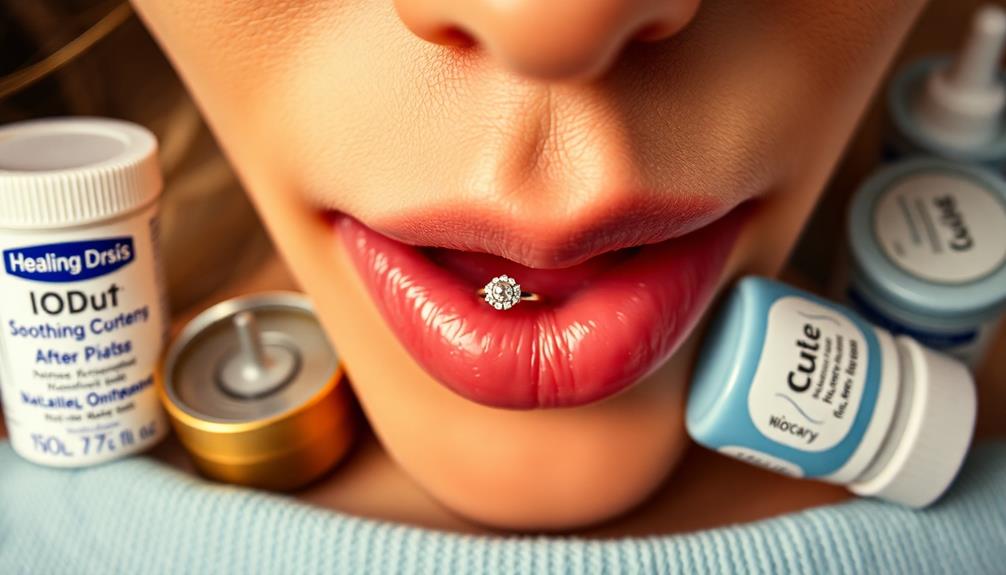
When you get a nipple piercing, expect the healing process to take anywhere from 6 to 12 months.
In the initial weeks, you'll notice soreness and swelling, but by 3 to 4 weeks, those symptoms should start to ease up.
It's vital to watch for signs of proper healing and know how to manage any complications that might arise.
Expected Healing Timeline
The healing timeline for nipple piercings typically spans from 6 to 12 months, with the initial healing phase occurring in the first 6 to 8 weeks.
During this time, you might experience soreness, swelling, and minor bleeding, especially in the first 1 to 2 weeks, when sensitivity is at its peak.
As you progress to 3 to 4 weeks, you should notice a decrease in pain and swelling, although clear lymph fluid may still be present. This discharge is a normal part of the healing process.
By the time you reach 4 to 5 months, the outer healing may appear complete, but remember that the inner tissues can take several more months to fully heal.
It's essential to maintain proper aftercare throughout this period to minimize infection risk.
Avoid changing your jewelry too soon; consult your professional piercer to verify your nipple piercings are fully healed before making any changes.
This careful attention to the expected healing timeline will help you enjoy your new piercings without complications, allowing your body to heal properly.
Signs of Proper Healing
Recognizing the signs of proper healing for your nipple piercings is essential to guarantee everything is progressing as it should. Typically, healing takes 6 to 12 months, with noticeable changes occurring as time goes on.
In the first 1-2 weeks, expect soreness, swelling, and minor bleeding, along with heightened sensitivity. By 3-4 weeks, you should see a decrease in pain and swelling, and clear lymph fluid may appear, signaling that healing is on track. After 4-5 months, while outer healing might seem complete, the inner tissue can still be maturing.
To help you monitor your healing, here's a quick reference table:
| Healing Phase | Signs of Proper Healing |
|---|---|
| 1-2 Weeks | Soreness, swelling, minor bleeding |
| 3-4 Weeks | Decreased pain, clear lymph fluid |
| 4-5 Months | Completed outer healing, mild itching |
Keep an eye out for persistent redness or discharge, as these could indicate complications. Following proper aftercare routines will further support your healing journey.
Managing Healing Complications
Healing complications can arise during the 6 to 12 months it takes for nipple piercings to fully recover. The first few weeks are vital for aftercare, as this is when soreness and swelling peak.
While some lymph fluid discharge is normal, you should monitor for infection by looking for signs like pus, increased warmth, or severe pain. If you notice any concerning symptoms, don't hesitate to contact a professional piercer or a medical professional.
To manage healing complications effectively, follow a consistent aftercare routine. Clean your piercings daily with a saline solution and avoid irritants like tight clothing or harsh soaps. This helps promote proper healing and reduces the risk of an infected nipple piercing.
Regular monitoring for signs of healing—such as a decrease in redness and pain—is essential.
If you experience persistent redness or increased discomfort, these may signal healing complications. Addressing these issues early can make a significant difference in your recovery.
Aftercare Best Practices
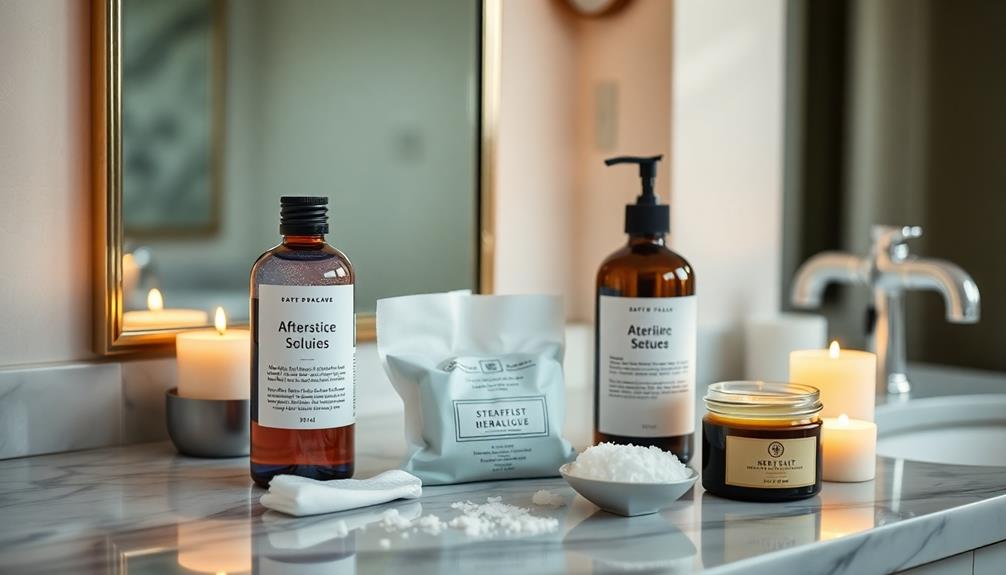
Caring for your nipple piercings properly is vital for a smooth healing process. Start by cleaning your piercing at least twice daily using a sterile saline solution and a gentle, unscented soap. This promotes ideal healing and helps prevent infection during the healing time.
Soaking your piercing in a non-iodized sea salt solution for 5-10 minutes twice a day can also aid in healing and reduce irritation.
During the healing period, wear loose-fitting cotton clothing to minimize friction and irritation around the piercing site. It's important to avoid touching the jewelry or the piercing with unwashed hands, as this can introduce bacteria and increase the risk of infection.
Make it a habit to monitor the piercing regularly for any signs of infection, such as increased redness, swelling, or unusual discharge. If you notice any concerning symptoms, consult a professional body piercer for guidance.
Potential Side Effects
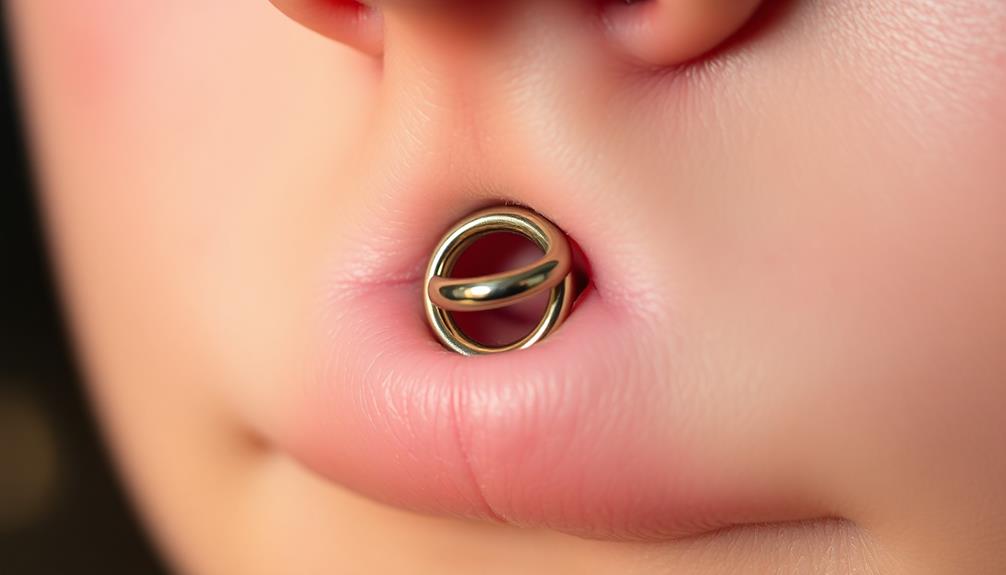
During the healing process, you might encounter several potential side effects associated with nipple piercings. Understanding these common side effects can help you manage your healing time and guarantee proper aftercare.
Here are four key issues to watch for:
- Hypergranulation: This appears as fluid-filled tissue around the piercing site, often due to irritation.
- Infections: Symptoms like persistent redness, swelling, pain, or cloudy discharge require prompt medical attention.
- Lymph Fluid Discharge: Typically clear to whitish, this is a normal part of the healing process and indicates your body is working to heal.
- Scarring: You may experience scarring, including keloid scars, especially if you're prone to hypertrophic scarring.
Additionally, increased sensitivity and discomfort during menstruation are common and should be monitored.
While these side effects can be alarming, understanding them can help you differentiate between normal healing symptoms and potential complications.
Prioritize your aftercare to minimize risks, and don't hesitate to seek professional advice if you notice severe symptoms.
Jewelry Selection and Care
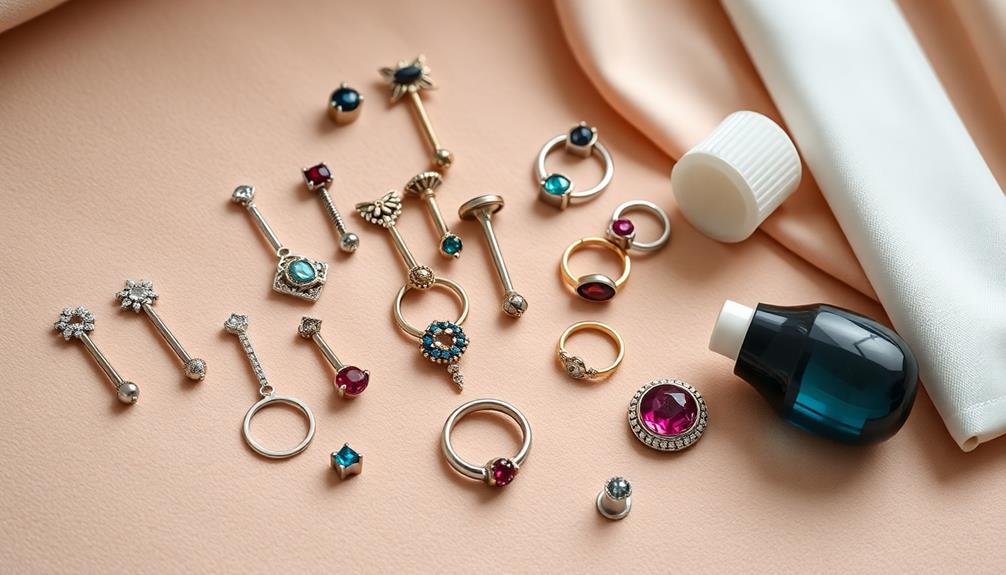
Choosing the right jewelry for your nipple piercings is important for both comfort and healing. Start with a 14 or 12-gauge straight barbell to accommodate initial swelling and promote faster healing. The material you select plays a significant role; titanium is hypoallergenic and nickel-free, making it a great option if you have metal sensitivities.
On the other hand, surgical stainless steel contains trace nickel, which may not be suitable for everyone. Confirm your jewelry is appropriately sized to prevent complications. Longer barbells can help during the swelling phase, while heavy or dangling jewelry should be avoided to reduce strain on the piercing.
Once your nipple piercings have healed, you might consider switching to captured bead rings or other styles. Consult a professional piercer for guidance on this change to guarantee proper assessment and care.
Regularly inspect your jewelry for signs of wear or damage. Cleaning your jewelry frequently is essential for maintaining hygiene and preventing infection.
Frequently Asked Questions
How Long Until Nipple Piercings Stop Hurting?
You'll notice the pain from nipple piercings peaks right after the procedure but starts to lessen within a few weeks. Expect significant improvement around the 3-4 week mark, with full healing taking up to a year.
What Are the Stages of Healing a Nipple Piercing?
You'll experience several healing stages: initial soreness and swelling, then decreasing pain over weeks. Expect itching and lymph fluid as healing progresses. Full recovery takes 6 to 12 months, so be patient with your piercing.
How Long Does It Take to Recover From a Nipple Piercing?
Recovery from a nipple piercing usually takes about 6 to 8 weeks for initial healing. Complete healing can extend up to 12 months, so you'll need to maintain diligent aftercare during this time.
How Do You Relieve the Pain of a Nipple Piercing?
To relieve pain from your piercing, try taking over-the-counter pain relievers, apply a sterile saline solution for cleaning, wear loose clothing, and avoid tight bras. Regularly assess your discomfort and adjust your aftercare accordingly.
Conclusion
In the grand tapestry of body art, nipple piercings can be a bold choice, weaving personal expression with a touch of daring. While the pain might feel like a fleeting storm, the healing process reveals a beautiful transformation. With proper aftercare, you'll navigate this journey like a skilled sailor charting calm waters. Remember, the right jewelry can add that finishing touch, so embrace your adventure and let your individuality shine through like a star in the night sky.

